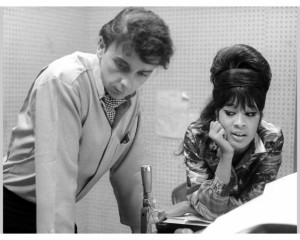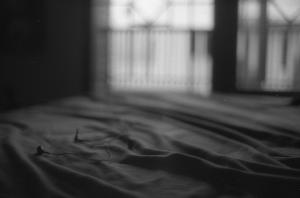“To be full of things is to be empty of God. To be empty of things is to be full of God.”
–Meister Eckhart
It seems rather ghastly now, given that he is serving a sentence of nineteen-years-to-life for murdering a cocktail waitress, but when I was in high school, I became obsessed with music producer Phil Spector—the eccentric and reclusive originator of the “Wall of Sound” that echoed from a dozen girl groups in the early 1960s.
I was a scholarship student at a fancy boarding school in Massachusetts where the workload was notoriously heavy and for me, particularly difficult. I failed a year of mathematics and made mediocre grades in everything else. Instead of studying, though, I sat around reading Tom Wolfe’s essay on Spector from The Kandy-Colored Tangerine-Flake Streamline Baby, which I kept checking out from the school library.
In a school where most students listened to the Grateful Dead, I photocopied old magazine articles on Spector, which I carried everywhere, like talismans. On weekend nights when the eighteenth century quadrangles would echo with twenty-minute Bob Weir guitar solos, I huddled in my room listening to an AM oldies station from Lowell, the signal occasionally blurred by bursts of static.
According to an article about Ronnie Spector I read in Interview magazine, when the former lead singer of the Ronettes was still married to Spector, he kept her a virtual prisoner inside his Bel-Air mansion. Once, she claimed, he threatened to shut her inside a glass coffin in the basement and just look at her.
From then on, whether trudging through snow across campus, or sitting in a darkened auditorium watching tapes of the Watergate hearings for History 300, I carried the idea of the glass coffin inside me as a place of repose. Whenever I was frightened or lonely—which was often—I could withdraw inside it.
I imagined descending, the small of my back touching its cool flat plane, the arresting stillness of a lack of air. My arms were graceful, arranged like the necks of swans; the soles of my feet just touched the coffin’s lip. From this awkward angle, I could behold everything. The transparent glass seemed to magnify objects outside of it like a lens. And above it, over all the things I saw, loomed Spector’s mysterious presence.
Certainly, the coffin scene in my mind was drenched in adolescent sexuality, albeit of a rather neurasthenic sort. Some girls in my dorm had a poster of Millais’s “The Death of Ophelia” on their wall that preoccupied me. There was something about the alliance of sex and a delicate masochism (Ophelia’s waxen white hands held out in the water’s shimmer) that was far more appealing than sex as it actually appeared to be practiced between average prep school students—a combative, greedy affair, about as subtle as a hockey game.
To me, sex seemed inextricably tied to death, and dissolution of boundaries, though at the time I wasn’t aware of this notion’s venerable history.
To submit oneself to the glass coffin, then, was to lay oneself bare to violation, and not merely to a sexual violation, but to something more transfiguring. I came to think that I gave myself up to the terrifying power of revelation. But as I gave myself up in my imagination to the coffin’s limitations, I discovered the most amazing paradox: I was freed to become an observer.
In surrendering all expectation, the world became magnified around me, infinite in the small. With all its illogic, the fantasy came to signify the creative possibilities inherent in capitulation. This was not something that my education encouraged.
For a school that prided itself on being politically progressive, we were encouraged to set about our studies with the voracity of nineteenth-century colonialists. Learning was framed in the language of mastery and conquest, but rarely awe. Even understanding came to have a certain violence, in the picture of these affluent teenagers from California and New York, glib with their shorthand for the universe.
It was an excellent education, but it was also like studying a vast historic temple—its intricate layout, its mosaics and friezes—in order to best discover how to raid the treasure.
The exception came in the spring trimester of my senior year. Mud season had ended, the lilacs were in bloom, and it was so warm and radiant that Mr. Thomas moved my History of Jazz Music class outdoors and brought along his saxophone.
Mr. Thomas was a tall, reserved black man who played in nightclub house bands and always wore a coat and tie. He said he was going to play a piece he composed about his sister, who was a manic-depressive. Ten or so students splayed out nervously in a circle on the grass. What if his playing were horrible? Or since we didn’t really think it would be bad—he was our teacher, after all—what if it were just embarrassing?
He began slowly, drawing out long lateral notes, like breaths. I knew nothing about musical composition, but as he played, I began to perceive architecture. What began as regularly as breathing rose, became giddy like laughter, but ever more frenzied until the notes spilled over themselves, blending into one another, hitting a high, thin sigh, and then falling into sobs.
Mr. Thomas was weeping and his sister was weeping in him. Then his playing became lower, heavier and dense, prolonged again, and finally resolved.
The class erupted in applause, but no one said a word. No one moved to leave. Mr. Thomas wiped his brow, which was glowing with sweat, and did not look at any of us. With a wave of his hand, he dismissed class.
Thus, for me the creative drive became to witness another so clearly, to submit myself in effect, so that I could become that Other. This was the transfiguration the glass coffin promised.
It is still the only means I’ve found to overcome violence and sorrow, and all that is unspeakable.












